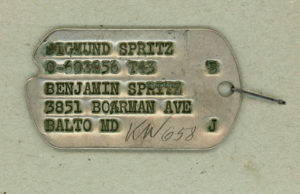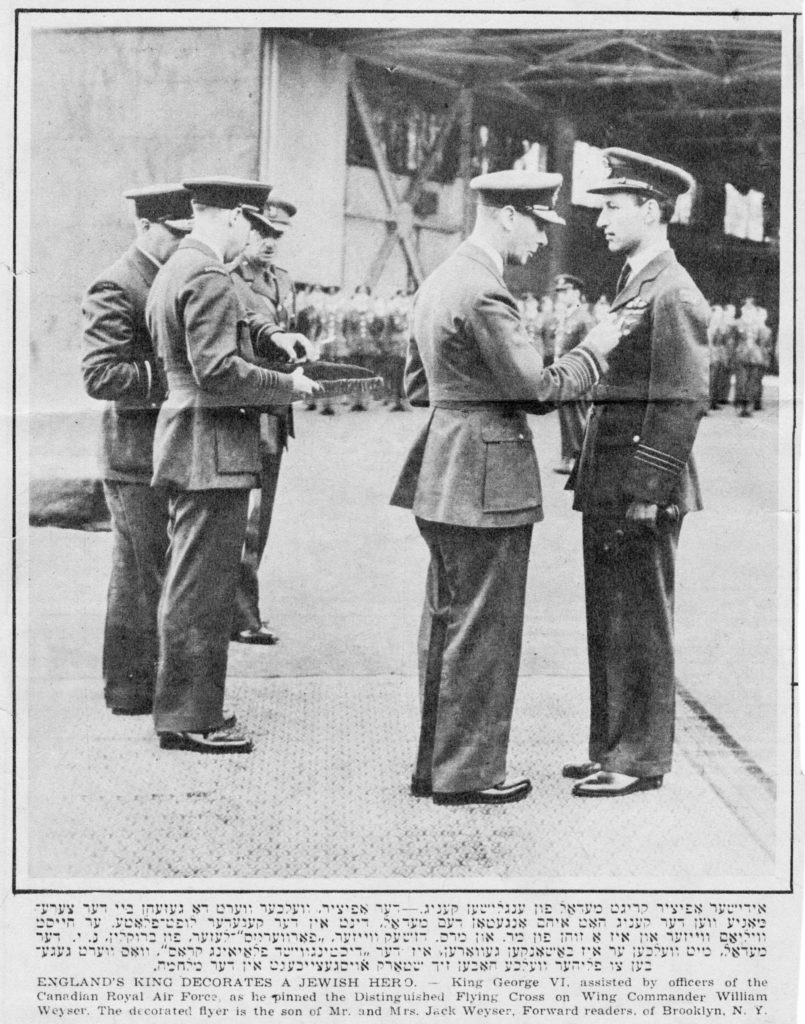Here’s a revision to this post, which originally appeared some time ago…
I recently discovered a photograph of Captain Howard Goodman in The Forward (Forverts) of July 5, 1943, and have now incorporated the picture – below – into this post. I discovered this image – purely by chance – while reviewing the newspaper at the website of the Historical Jewish Press, at the National Library of Israel.
Throughout the Second World War, and I suppose well before and years after, The Forward included within its pages many, many photographs of Jewish military personnel and sometimes, their families. These images appeared within specific news items directly pertaining to servicemen themselves, as “stand-alone” photo items, and especially, within the latter page of every issue, which comprised a selection of compelling, dramatic, topical, or just-plain-interesting recent photographs from both the United States and overseas.
Within these Forward photo pages, many – but certainly not all, at all – images illustrated Jewish personnel in the armed forces of the United States. Thus, the image of Captain Goodman, pictured in the act of receiving the Silver Star.
I may be able to bring you more such images, in the future.
______________________________
In the summer of 1943, both The New York Times and Brooklyn Eagle accorded recognition to a Jewish member of the Marine Corps – Captain Howard Kenneth Goodman, of Long Beach – for his receipt of the Silver Star, which was awarded in recognition of his service in the Solomon Islands, where he was wounded on November 3, 1942. Curiously, the Eagle’s article was more comprehensive, presenting both a photograph of Captain Goodman’s mother, and, the full award citation.
Wins Marines Medal
New York Times
July 3, 1943
 WASHINGTON, July 2 (U.P.) – Secretary Knox has awarded the Silver Star Medal to Captain Howard K. Goodman, U.S.M.C., 25, son of Mr. and Mrs. Samuel Goodman of Long Beach, L.I. Captain Goodman formerly lived at 1660 Crotona Park East, New York.
WASHINGTON, July 2 (U.P.) – Secretary Knox has awarded the Silver Star Medal to Captain Howard K. Goodman, U.S.M.C., 25, son of Mr. and Mrs. Samuel Goodman of Long Beach, L.I. Captain Goodman formerly lived at 1660 Crotona Park East, New York.
While still a First Lieutenant, Captain Goodman was cited for leading here successive bayonet and hand-grenade charges with minimum casualties to his men in the face of heavy-machine gun and mortar fire during the Solomons offensive.
Captain Goodman attended Long Beach High School before enrolling at City College, from which he was graduated with a Bachelor of Social Science degree. In college he was a member of the editorial staff of The Campus, the college orchestra and the ROTC band.
He enlisted in the Marines on July 3, 1941, soon after he was admitted to the bar of New York State after three years at Columbia Law School.
Captain Goodman’s pre-war residence, at 1660 Crotona Park East.
 Leatherneck Captain Gets Star for Leading 3 Charges on Japs
Leatherneck Captain Gets Star for Leading 3 Charges on Japs
Brooklyn Eagle
July 2, 1943
For “leading three successive bayonet and hand grenade charges against the Japanese,” Capt. Howard K. Goodman, U.S.M.C.., of 1012 W. Beach St., has been awarded the Silver Star medal by Secretary of the Navy Frank Knox.
West Beach Street, in the Bronx of 2016. The Saloon Restaurant (actually, at 1016 West Beach Street) now occupies the location where the home of Rose Goodman once stood.
 While he was still a first lieutenant, Goodman was cited for leading three successive charges in the face of heavy machine gun and mortar fire with minimum casualties to his men. He accomplished this feat during the Solomons offensive.
While he was still a first lieutenant, Goodman was cited for leading three successive charges in the face of heavy machine gun and mortar fire with minimum casualties to his men. He accomplished this feat during the Solomons offensive.
Yesterday his mother, Mrs. Samuel Goodman, received a letter from her hero son. He wrote: “It’s Captain Goodman now. Yes, I was promoted.” He gave the date as May 31 and went on to say that he had passed the physical examination, signed the acceptance and put on the bars. It would mean a raise and also a change of station, she added.
She’s ‘Very Proud Mother’
“I’m a very proud mother,” said Mrs. Goodman. “He always has been an exceptional boy. He didn’t hang around on the street corners like so many do. He was very studious.”
Goodman’s letter didn’t mention the award. He wrote he was going to have pictures taken as soon as he could get to town. “He has been to the movies, too,” said Mrs. Goodman. He saw “Keeper of the Flame.”
Goodman, 25, is a 1938 graduate of City College of New York and studied law at Columbia University. Shortly after he enlisted on July 3, 1941, he was sworn in as a member of the bar. In May, 1942, he went overseas.
The citation, which accompanies the award, reads:
“For conspicuous gallantry and intrepidity as a member of the First Marine Division during action against enemy Japanese forces in the Solomon Islands on Nov. 3, 1942. While temporarily attached to a battalion launching an assault against the enemy, 1st Lt. Goodman, in the face of heavy machine gun and mortar fire, led his platoon in three successive bayonet and hand grenade charges against the Japanese. By his outstanding leadership and courageous aggressiveness, he contributed to the annihilation of a hostile strong point of about one battalion, with minimum casualties to his own troops.”
______________________________
Here’s the photograph of Captain Goodman receiving the Silver Star, from The Forward of July 5, 1943.
 ______________________________
______________________________
Sadly, Captain Goodman did not survive the war. He was killed in action half a year later, on January 7, 1944.
Unlike the servicemen profiled in previous posts concerning The New York Times, that newspaper never published an obituary or retrospective concerning the Captain. Instead, his name simply appeared in Casualty Lists published in the Times (and Long Island Star Journal) on March 2, 1944, and the Nassau Daily-Review Star on February 16. Captain Goodman’s name also appeared in the “In Memoriam” section of the Times on February 6, 1947, and February 24, 1949. His awards comprised the Silver Star, Bronze Star, and Purple Heart with one Oak Leaf Cluster.
A member of M Company, 3rd Battalion, the 5th Marine Regiment, 1st Marine Division, Captain Goodman (serial number 0-8730) was buried at New Montefiore Cemetery, in West Babylon, New York (Block 6, Grave 4, Section 3, Long Beach Brith Abraham Society) on February 6, 1949.
Some other Jewish military casualties on Friday, January 7, 1944, include…
Killed in Action
– .ת.נ.צ.ב.ה. –
Becker, Sidney, 2 Lt., 0-741226, Bombardier, Purple Heart
United States Army Air Force, 8th Air Force, 445th Bomb Group, 701st Bomb Squadron
Mrs. Elaine B. Becker (wife), 2910 Madison Ave., Newport News, Va.
Born 11/12/19
MACR 15103; Aircraft: B-24H 41-29119; Pilot: 2 Lt. Lester I. Eike; 10 crewmen – 4 survivors
Aircraft crashed at Wethingsett, Suffolk, England, on return from mission to Ludwigshaven
Jewish Cemetery of the Virginia Peninsula, Hampton, Va. (Photo of Matzeva by Dawn Stewart.)
American Jews in World War II – 577
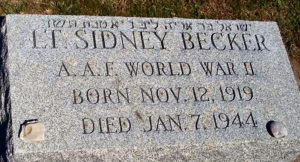 ______________________________
______________________________
Briskman, Edward, Pvt., 32880900, Purple Heart
United States Army, 34th Infantry Division, 168th Infantry Regiment, G Company
Mrs. Fanny Briskman (mother), 2959 Nostrand Ave., Brooklyn, N.Y.
Born 5/10/24
Long Island National Cemetery, Farmingdale, N.Y. – Section H, Grave 11026
Casualty List 3/8/44
American Jews in World War II – 284
Friedman, Morris Samuel, 2 Lt., 0-682101, Bombardier, Purple Heart
United States Army Air Force, 8th Air Force, 96th Bomb Group, 337th Bomb Squadron
Mrs. Alice S. Friedman (wife), 1823 Maple St., Bethlehem, Pa.
Born 1921
MACR 2018; Luftgaukommando Report KU 660; Aircraft: B-17F 42-30130 (“The Klap Trap II”, “AW * J”) Pilot: 2 Lt. Roland E. Peterson; 10 crewmen – 2 survivors [Right Waist Gunner Sgt. William Brian Roberts, and Tail Gunner Sgt. Andrew Francis Weiss]
Netherlands American Cemetery, Margraten, Netherlands – Plot O, Row 20, Grave 12
American Jews in World War II – 522
______________________________
Heilbronn, Eric Moses (Moshe ben Yitzhak), Pvt., 32816833, Purple Heart
United States Army, 34th Infantry Division, 168th Infantry Regiment, A Company
Rabbi Isak [6/4/80-6/9/43] and Mrs. Erna Esther [2/9/92-5/3/77] Heilbronn (parents), Cecil and Irmgard (Pinto) Heilbronn, 382 Wadsworth Ave., New York, N.Y.
Born Nurnberg, Germany, 1924
Burial location unknown
Casualty List 2/22/44
Aufbau 5/12/44
American Jews in World War II – 342
The May 12, 1944 edition of Aufbau, which carried news about Private Heilbronn, is shown below:
Here is the news item about Private Heilbronn, which is followed by a transcription of the German text, and an English-language translation:
ist im Alter von nur 20 Jahren auf dem italienischen Kriegsschauplatz gefallen. Er war seit dem 7 Januar dieses Jahres als vermisst gemeldet, aber erst vor wenigen Tagen hat seine Mutter die Nachricht von seinem Tod erhalten.
Pvt. Heilbronn ist der Sohn des ihm sieben Monate im Tod vorangegangenen Rabbiners Dr. Isaak Heilbronn und stammte aus Nurnberg. Er widmete such insbesondere der Jugendbewegung innerhalb der Gemeinde seines Vaters, der Congregation Beth Hillel, und versuchte, die eingewanderte deutsch-jüdische Jugend mit der americanischen Weltanschauung vertraut zu Machen und sie fur die Ideale Amerikas zu begeistern.
Pvt. Heilbronn kam Antang 1939 nach Amerika, absolvierte die High School in New York und nahm später Abendkurse in Buchprüfung am City College. Tagsüber war er bei der Federation of Jewish Charities beschaftigt. Im März 1943 rückte er in die Armee ein.
Pvt. Eric M. Heilbronn
died at the age of only 20 in the Italian theater of war. He was reported missing since January 7 of that year, but only a few days ago his mother received the news of his death.
Pvt. Heilbronn is the son of Rabbi Isaac Heilbronn from Nurnberg, who died seven months before his death. He was particularly dedicated to the youth movement within his father’s congregation, Congregation Beth Hillel, and tried to familiarize immigrant German-Jewish youths with the American world view and to inspire them with the ideals of America.
Pvt. Heilbronn came to America in 1939, graduated from high school in New York and later took evening classes in auditing at City College. By day he was employed by the Federation of Jewish Charities. In March 1943 he joined the army.
______________________________
Malkin, losif Borisovich (Малкин, Иосиф Борисович), Senior Sergeant [Старший Сержант]
U.S.S.R., Red Army, 32nd Tank Brigade
Radio Operator
Born: 1925
Probable place of burial: Ukraine, Kirovograd oblast, city of Kirovograd
Memorial Book of Jewish Soldiers Who Died in Battles Against Nazism – 1941-1945 – Volume II – 464 [Книги Памяти евреев-воинов, павших в боях с нацизхмом в 1941-1945 гг – Том II – 464]
______________________________
Roodman, Harold, 2 Lt., 0-796603, Navigator, Distinguished Flying Cross, Purple Heart
United States Army Air Force, 8th Air Force, 389th Bomb Group, 566th Bomb Squadron
Mrs. Jackie R. Roodman (wife) [4/11/23-1/4/98], Ronnie Lee Roodman (son), 706 West 179th St., New York, N.Y.
Born 1917
11/17/43, 2/27/44, 4/20/44
MACR 1853; Luftgaukommando Report KU 666; Aircraft: B-24D 42-41013 (“Trouble”; “RR * K+”); Pilot: Capt. David L. Wilhite; 11 crewmen – 1 survivor (Sgt. Robert H. Sweatt, of Lovington, New Mexico). Shot down at Bolbec, France
Loss of aircraft described in Escape & Evasion Report # 535, by Sgt. Robert H. Sweatt
Long Island National Cemetery, Farmingdale, N.Y. – Section J, Grave 14445; Buried 8/24/49
P.M. – 9/3/43
Jews Fight Too, p. 202
American Jews in World War II – 415
Name listed in “List of Ploesti Mission Award Recipients” – Published 11/17/43 (“Awards Given for 1,548 in Ploesti Attack”). Listed as recipient of Distinguished Flying Cross
Casualty Lists – 2/27/44 (Missing in Action), 4/20/44 (Killed in Action)
Lt. Roodman, a member of the 389th “Sky Scorpions” Bomb Group, participated in the Ploesti bombing mission of August 1, 1943 as a member of the crew of Richard B. Smith. He’s presumably one of the crewmen in the photograph below (image UPL 15403, at the American Air Museum in Britain) though “who is who”, is unknown, as the caption only lists the name of Lt. Smith. Lt. Roodman was also among the 1,548 men whose names were published as award recipients for the Ploesti mission, in a War Department Release of November 16, 1943.
 Continuing to fly missions, Lt. Roodman was one of the eleven crewmen aboard Trouble, a B-24D Liberator shot down over Bouville, France – according to information compiled by Jan Safarik – by an FW-190 of Stab / Jagdgeschwader 2 Richthofen.
Continuing to fly missions, Lt. Roodman was one of the eleven crewmen aboard Trouble, a B-24D Liberator shot down over Bouville, France – according to information compiled by Jan Safarik – by an FW-190 of Stab / Jagdgeschwader 2 Richthofen.
Information about the plane and crew can be found at Daniel Carville’s France Crashes website.
A memorial honoring the plane’s fallen crew members, dedicated to sole survivor Sgt. Robert H. Sweatt, can be found at Bouville’s town church, which is located on the southwest corner of the Place de l’Eglise. Mounted on the exterior wall adjacent to a monument commemorating the community’s fallen of World War One, the memorial includes a plaque listing the plane’s crew members, and, a painting of Trouble in flight. (I’d typically include the images from that website “here” – at this post – but since they’re copyrighted (!) I refer you to AeroSteles, where these images are on display.) Instead, the memorial can be seen in the photograph below, by Arnaud Théron:
 Sergeant Sweatt, who evaded capture and returned to England on March 26, 1944, described his survival in Escape & Evasion Report 535, part of which is presented below. The “strikethroughs” and text in red represent changes to Sgt. Sweatt’s report which appear in the actual document. (You can read the full report here.)
Sergeant Sweatt, who evaded capture and returned to England on March 26, 1944, described his survival in Escape & Evasion Report 535, part of which is presented below. The “strikethroughs” and text in red represent changes to Sgt. Sweatt’s report which appear in the actual document. (You can read the full report here.)
We were flying on our course returning from our target at Wilhelmshaven on 7 January 1944. Near Chartres fighters attacked us. Our ship seemed to stop dead in mid-air. I was hit. Arm had been hit, and I had to out on my chute with one hand. Suddenly I was thrown against the other waist gunner, and as I stumbled to my feet I heard a loud explosion. I remember that my head and shoulders were pushed out of the waist window, but the next thing that I recall is falling through the air.
I pulled my ripcord and then saw pieces of our ship all about me and a fully inflated dinghy floating above me. The field in which Ianded was frozen. I landed in a field, and took off my harness, and found when I tried to bury my chute that the ground was frozen. [but could not bury my chute in the frozen ground] I then ran [300 yds] to a clump of trees and sat down next to a stock of grain in this grove [grain-sheaves]. Half a dozen Frenchmen suddenly sprang up all around me [surrounded me]. One of them asked whether I was English, and when I answered “American” he pulled off his clothes and gave them to me. After I had put [them on and my flying clothes] on these clothes and my heated suit and flying boots had been hidden in the grain sheaves, three young French men and I walked across the fields. We had not gone 300 yards when a German soldier came towards us and called for us to halt. One of the Frenchmen motioned me to stay where I was, and he went forward and talked to the soldier for several minutes. Finally the German made two of the young men pick up a large piece of metal from our ship and carry it to a car, which was standing on a hill about 400 yards away in the distance. I motioned to the other Frenchman, and we snatched grabbed another piece of metal and walked off towards the car. After we had gone about 400 yards I ducked into a [clump] growth of trees and covered myself with leaves and twigs. I remained hidden here for six hours, and after dark the young Frenchman and his father returned in a cart, took me to their house, and put me to bed. They kept me in bed for five days while they treated my wounds and then took me to another farmhouse from which where the rest of my journey was arranged.
Postwar, Robert Sweatt became a rancher in Texas.
But, there’s more to the story. (There’s always more to every story.) To be specific, two photographs. One image – an excellent image, at that – is an official Army Air Force photograph photo B-27323 AC / 3A16214, showing of Trouble, in flight. Among six B-24s over Cognac, France, the aircraft appears in the lower foreground. The plane’s nose art and aircraft letter (K+) are plainly visible, as are the waist gunners (seen through the open waist windows) and pilot. The photograph was taken some time before February 8, 1944.

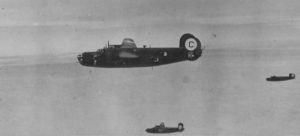 A close-up of Trouble’s nose art, from Database Memoire.
A close-up of Trouble’s nose art, from Database Memoire.
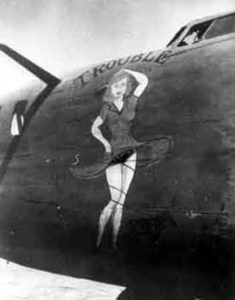 The other image is very different. Found via Thomas M. Tryniski’s remarkable FultonHistory website, it lends a striking poignancy to an ostensibly straightforward chronicle of dates and events: A photo of Jackie Roodman and Ronnie Lee Rodman, the young wife and four-month-old son of Lt. Roodman.
The other image is very different. Found via Thomas M. Tryniski’s remarkable FultonHistory website, it lends a striking poignancy to an ostensibly straightforward chronicle of dates and events: A photo of Jackie Roodman and Ronnie Lee Rodman, the young wife and four-month-old son of Lt. Roodman.
 Published in P.M. on September 3, 1943, under the title “V-Mail Photos for Dads in Service”, this feature seemed to have been a regular feature of P.M., at least going by its instructions: “If your baby is less than a year old and was born after your husband went into service overseas, we’ll take a picture of you and the child and reprint it on a V-Mail blank which you can mail to your husband. Call Sterling 3-2501 between 10 a.m. and 5 p.m. and ask for the V-Mail Editor. There is no charge for this service, which is restricted to New York City.”
Published in P.M. on September 3, 1943, under the title “V-Mail Photos for Dads in Service”, this feature seemed to have been a regular feature of P.M., at least going by its instructions: “If your baby is less than a year old and was born after your husband went into service overseas, we’ll take a picture of you and the child and reprint it on a V-Mail blank which you can mail to your husband. Call Sterling 3-2501 between 10 a.m. and 5 p.m. and ask for the V-Mail Editor. There is no charge for this service, which is restricted to New York City.”
Jackie Roodman passed away on January 4, 1998. She is buried next to her husband at Long Island National Cemetery, in Farmingdale, New York. Her Honor Record in his memory can be seen at the Registry of the National WW II Memorial.
Rappaport, Samuel, Pvt. (on Bougainville)
United States Army
Mrs. Sadie Krasner (sister), Harry (brother), 1001 Lincoln Place, Brooklyn, N.Y.
Born Toronto, Ontario, Canada, 1920
Brooklyn Eagle and New York Times 2/8/44
American Jews in World War II – 410
Tate, Daniel, Pvt., B/40356
Canada, Royal Canadian Infantry Corps, Canadian-American First Special Service Force
Mr. Samuel Tate (father), Harry (brother), 365 Huron St., Toronto, Ontario, Canada
Canadian Jews in World War II – Part II: Casualties – 117
Turiansky, George Gordon, 1 Lt., Distinguished Flying Cross, Air Medal, 3 Oak Leaf Clusters, Purple Heart, 30 missions
United States Army Air Force, 8th Air Force, 92nd Bomb Group, 325th Bomb Squadron
Wounded over Ludwigshaven, Germany
Mr. Abraham Turiansky (father), 707 Beverly Road, Brooklyn, N.Y.
Miss Elaine Brown (fiancee)
Born 1923
Aircraft: B-17
Brooklyn Eagle 7/21/44
American Jews in World War II – 462
Prisoners of War
Hirsch, Robert H., 2 Lt., 0-805918, Co-Pilot
United States Army Air Force, 8th Air Force, 389th Bomb Group, 565th Bomb Squadron
SL 3 Sagan (33) (Compound unknown); S 7A Moosburg (13)
Mrs. Ruth B. Hirsch (wife), 715 Veronica Ave., East Saint Louis, Il.
Born Rochester, N.Y., 5/2/22
MACR 1852; Luftgaukommando Report KU 663; Aircraft: B-24H 42-7593 (“Blunder Bus!”); Pilot: 2 Lt. Royce E. Smith; 11 crewmen – 9 survivors
American Jews in World War II – Not listed
A nice image of Blunder Bus!’ nose art, from B-24 Best Web. Unfortunately, the crewmen are unidentified.
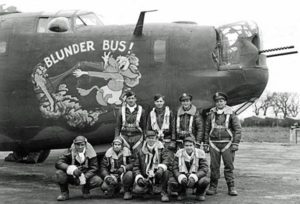 ______________________________
______________________________
Spritz, Sigmund, 2 Lt., 0-682256, Navigator
United States Army Air Force, 8th Air Force, 93rd Bomb Group, 328th Bomb Squadron
Evaded capture through 2/29/44
SL 3 Sagan (33) (West Compound); S 7A Moosburg (13)
Mr. Benjamin H. Spritz (father), 3851 Boarman Ave., Baltimore, Md.
Born Baltimore, Md., 8/6/17; Died 1/5/94
Casualty List 6/21/45
MACR 2368; Luftgaukommando Report KU 658; Aircraft: B-24H 42-7614 (“Lady Shamrock”; “K”) Pilot: 2 Lt. James Carnahan; 10 crewmen – 8 survivors
American Jews in World War II – Not listed
Three of Lady Shamrock’s crewmen – Right waist gunner S/Sgt. Robert J. Fruth, co-pilot 2 Lt. Edward C. Miller, radio operator S/Sgt. Willis E. Spellman, evaded capture, with Spellman known to have returned Allied control by March 20. Two other men – left waist gunner Sgt. Jay W. Stearns and tail gunner S/Sgt. William D. Wahrheit – did not survive the mission.
Lt. Spritz was captured and survived the war as a POW.
Though there is only nominal mention of him in Lady Shamrock‘s Missing Air Crew Report, an altogether different document sheds highlight about his experience after parachuting from the Liberator…
Lt. Spritz was able to evade capture until February 29, 1944, when he was apprehended by the German SD (Sicherheitsdienst – Security Service) and brought to a prison in Fresnes. This is confirmed in his story of (temporary) evasion, published in The Baltimore Sun on January 11, 1994, at his FindAGrave biographical profile. The account is presented below:
Sigmund Spritz, who as a prisoner of the Germans during World War II credited his survival to the American Red Cross packages that occasionally reached camp, died Wednesday of an upper respiratory infection at Sinai Hospital. The Northwest Baltimore resident, a retired optometrist, was 76.
He’d been a navigator aboard a B-24 bomber that was hit by flak during a raid over Ludwigshafen, Germany, forcing the crew to bail out over Melun, France.
Mr. Spritz parachuted into woods and stayed there for three days before being taken to the home of a farmer who hid him for several days.
“About 30 people came the next day bringing gifts to me. They treated me like a god,’’ he said in a 1965 Evening Sun interview.
The local priest provided him with false identification papers and the identity of a deaf-mute from a town whose records had been destroyed by Allied bombing. Contact was made with an English woman living in Paris who had French underground connections, and he was sent there – but not before spending several terrifying hours waiting for the train surrounded by German soldiers.
He avoided capture in Paris for nearly three months until an escape attempt went awry. A British torpedo boat with which he had rendezvoused hit a reef and began to sink. The boat drifted back to the French coast where its occupants were arrested. He convinced a Gestapo interrogator he was a flier and not a spy and was sent to jail in Paris.
After spending time in several camps, he and several thousand other prisoners were marched through a blizzard, packed aboard stock cars and shipped to Nuremberg and eventually to the Moosburg prison camp, where his ordeal of 20 months came to an end when the camp was liberated in May 1945 by Gen. George S. Patton’s 3rd Army.
He said he’d liked the dark German bread that his captors fed him but never learned to like the soup they called “green death,’’ which was a camp staple. He attributed his survival to the Red Cross packages that contained powdered milk, canned butter, cigarettes, matches and soap. They were “the difference between starvation and life,’’ he said.
Born and reared in Baltimore, he was a 1933 graduate of City College and earned his bachelor’s degree from Towson State College in 1940. He taught elementary school before enlisting in the Army Air Corps in 1941. He was discharged with the rank of lieutenant in 1945 and was awarded the Bronze Star and the Purple Heart.
But, there is even more confirmation of his story. This is an “Admission Notice” – an “Einlieferungs-Anzeige” – filed by the Germans after Lt. Spritz’s capture. Found with his dog-tags in the Luftgaukommando Report for Lady Shamrock (in the National Archives) the Admission Notice contains a fascinating clue: The “Day / time of admission” (to the prison) is recorded as 8:00 A.M. on February 29, 1944, nearly two months after Lady Shamrock was shot down.
Lt. Spritz’s dog-tag and prison Admission Notice are show below, along with the latter’s translation. (It’s also notable that the Germans listed his “creed” as Catholic, despite the “J” stamped upon his dog-tag…)
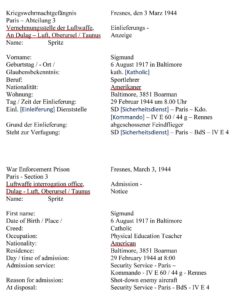 You can find more information about Luftgaukommando Reports here and here, at my brother blog, ThePastPresented.
You can find more information about Luftgaukommando Reports here and here, at my brother blog, ThePastPresented.
______________________________
S/Sgt. Irving J. Balsam and 2 Lt. Manuel M. Rogoff served in the same air crew. Assigned to the 389th Bomb Group’s 567th Bomb Squadron (8th Air Force), their B-24D Liberator 42-40747 (“Heavy Date”), piloted by 1 Lt. Carl A. Mattson, was shot down during a mission to the oil refinery at Ludwigshaven, Germany. The aircraft’s loss is covered in MACR 1851, and, Luftgaukommando Report KU 667. Of the plane’s crew of ten, there were 5 survivors. The other survivor from the forward part of the aircraft was the co-pilot, while from the rear, the ball turret gunner, right waist gunner, and tail gunner survived. All survivors except the ball turret gunner evaded capture and returned to England by March, 1944.
Balsam, Irving J., S/Sgt., 12183535, Gunner (Left Waist), Air Medal, Purple Heart, ~ 6 missions
KIA
Mr. and Mrs. Hyman [11/2/47] and Gussie [10/28/51] Balsam (parents), 2928 West 21st St., Brooklyn, N.Y.
Mount Zion Cemetery, Maspeth, N.Y. – Path 1, Lot 30R, Kremenitzer Society; Buried 10/21/48
Casualty Lists 2/17/44, 3/28/44
American Jews in World War II – 269
Rogoff, Manuel M., 2 Lt., 0-678392, Bombardier, Air Medal, Purple Heart, 7 missions
WIA (severely burned); Evaded capture; Returned to Duty 3/17/44
Mr. and Mrs. Jacob and Edith Rogoff (parents), Bernard and Leonard (brothers), 1146 Maplewood Ave., Ambridge, Pa.
Born 2/11/17; Civilian occupation: Businessman
Escape & Evasion Report 465
American Jews in World War II – 546
An edited extract from Lieutenant Rogoff’s Escape & Evasion Report (the full document is longer and more detailed) is presented below. As is obvious from the story, Lt. Rogoff was very badly burned upon exiting his bomber through the nose-wheel opening, but recovered from his injuries due to the care and diligence of his helpers and rescuers. As in the above Report for Sergeant Sweatt, “strikethroughs” represent textual changes which appear in the actual document. (You can read the full report here.)
First account of bailing out.
The time of the attack was approximately 1:30 P.M. about one half hour from the coast. The three F.W. 190s attacked from two o’clock low out of a haze that persisted from the right side.
The aircraft were sighted when at point blank range then two in tight formation fired 20 mm & machine guns simultaneously riddling the ship from behind the nose to the length of the waist.
**********
I turned my attention to the fire which was of a bright red or scarlet color. After a quick examination I found there was no fire extinguisher. I grabbed the B3 bag of the navigator’s to try to smother the fire. After an abortive attempt I gave this up because I could not squeeze through the narrow openings. I turned back reconnected my oxygen line. The fire spread and as if under pressure, had spread until the flames reached past the navigator’s desk. I entered the fire and opened the nose wheel door after three attempts. I hoped that the slip stream might extinguish the blaze.
Perceiving that it had no effect and that the fire increased I handed the navigator his chest chute and told him to jump. ********** I motioned for him to follow me and entered the flames and left the ship.
At the time of leaving the ship was in level flight and in seemingly perfect working order. The interphone to my knowledge was inoperative or unused. The nose was beginning to burn; a parachute belonging to the original crew had ignited; my summer flying suit had burned in spots.
I left the airplane head first, was twisted about severely by the slip stream, then found myself falling in slow turns. With my hands at my side I spread my legs thus stopping that motion and heading straight down in a 135 [degree] angle. I reached for my rip cord counted a rapid ten and pulled sharply. The chute opened with a rough jerk but as the straps were very secure I suffered no ill effect. I glanced up saw our ship in straight flight then saw it go into a left banked turn. A guest of wing turned me and I lost sight. In a minute a formation of Liberators passed overhead. I noticed three other chutes in the air off at some distance from me that I believe belonged to members of the same crew.
Was up there from 10 or 12 minutes. About 1000 feet noticed I was going to hit. I pulled _____ up hit a plowed field and tumbled in the chute.
Second account of bailing out, including highlights of assistance by French civilians.
We were attacked by FW-190s half an hour inland from the coast on our way to the target.
Our ship was burning when I bailed out at 21,000 feet. I was temporarily blinded by the flames and pulled my rip-cord after counting ten. My chute opened with a considerable jerk, but my harness was tight and I was not hurt by it.
On my way down I noticed about 50 people running to meet me. I landed in a plowed field and several of the men helped me to my feet and took my chute. After some discussion one of the men motioned to me to follow him, and we went to an old stone barn a few hundred yards away. There he spread butter on my face, which was very painfully burned.
I was taken to the house and all identification was removed except my dog-tags. My friends fitted me out with a beret, a heavy leather overcoat, and a pair of white shoes. They pooled their money and got together their 1250 Francs, which they gave me. Then they treated my burns again with more butter and I followed two of the men out.
We skirted fields and my helpers stopped once in a while to pick up RAF leaflets, and one of them found an American flying jacket which he kept. In about twenty minutes we came to a peasant’s house, where I was given brandy and put to bed.
For the next month or so I was blind and helpless. I was moved about from house to house and was under the constant care of physicians, to whose skill I probably owe my sight. In spite of the great difficulty and danger involved because of my conspicuous injuries, my helpers did not relax their vigilance and care and got me out care and successfully arranged my journey as soon as I was able to see.
______________________________
Another Incident: Crash-landed his fighter plane, but “walked away”…
Bloom, Herman Ben, Lt., 0-736958, Fighter Pilot, Air Medal, Bronze Star Medal, Purple Heart
United States Army Air Force, 10th Air Force, 311th Fighter Group, 529th Fighter Squadron
Injured; Crash-landed due to engine failure 20 miles north of Sumprabum, Burma
Mrs. Ruth (Nasbarg) Bloom (wife), 1523 Federal, Denver, Co.
No MACR; Aircraft: P-51A 43-6193 (Record at Aviation Archeology)
Graduated from Advanced Flying School and Commissioned 1 Lt. on 2/16/43
American Jews in World War II – 58
Lieutenant Bloom’s portrait – found in the National Archives in Records Group 18-PU “Records of the Army Air Forces: Photographic Prints of Air Cadets and Officers, Air Crew, and Notables in the History of Aviation” – is shown below. You can read more about this collection in my post “Five Pilots in December“, at ThePastPresented.
Dublin, Louis I., and Kohs, Samuel C., American Jews in World War II – The Story of 550,000 Fighters for Freedom, The Dial Press, New York, N.Y., 1947.
Canadian Jews in World War II – Part II: Casualties, Canadian Jewish Congress, Montreal, Quebec, Canada, 1948.
Davis, Mac; Curley, James M.; Simon, Howard, Jews Fight, Too!, Hebrew Publishing Company, New York, N.Y., 1945
Memorial Book of Jewish Soldiers Who Died in Battles Against Nazism – 1941-1945 – Volume II [Surnames beginning with К (K), Л (L), М (M), Н (N)], Maryanovskiy, M.F., Pivovarova, N.A., Sobol, I.S. (editors), Union of Jewish War Invalids and Veterans, Moscow, Russia, 1995
B-24D Liberator 41-29119 (at American Air Museum)
B-24D Liberator 42-40747 (at American Air Museum)
B-24D Liberator 42-41013 (at Aerosteles, American Air Museum, and Database Memoire)
B-24H Liberator 42-7593 (at Aerosteles, American Air Museum, and B-24 Best Web)
P-51A Mustang 43-6193 (at Aviation Archeology)





